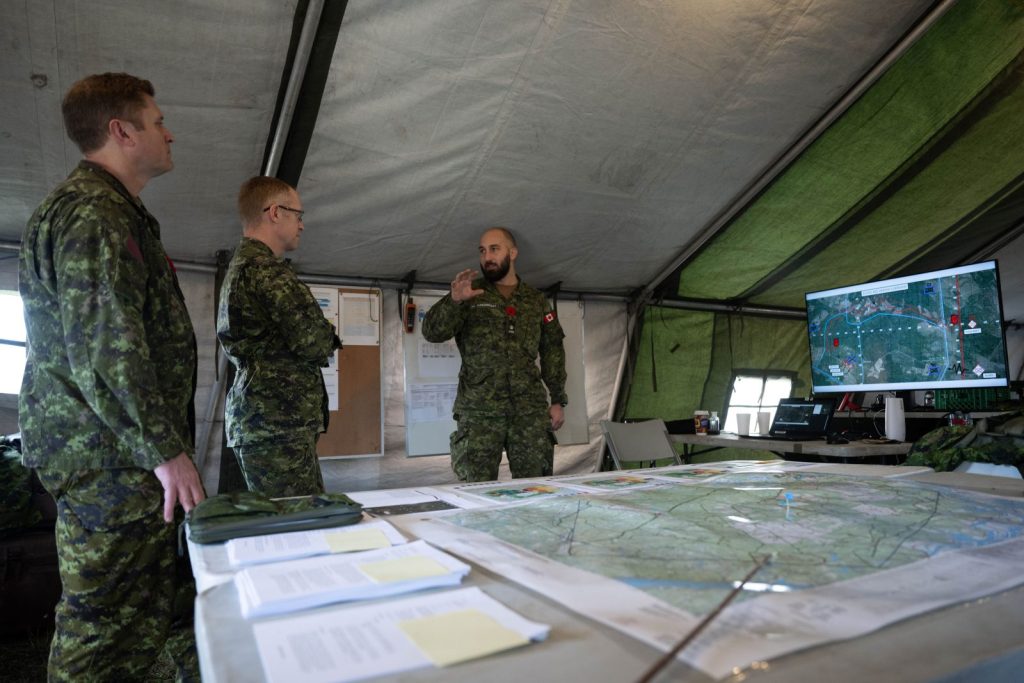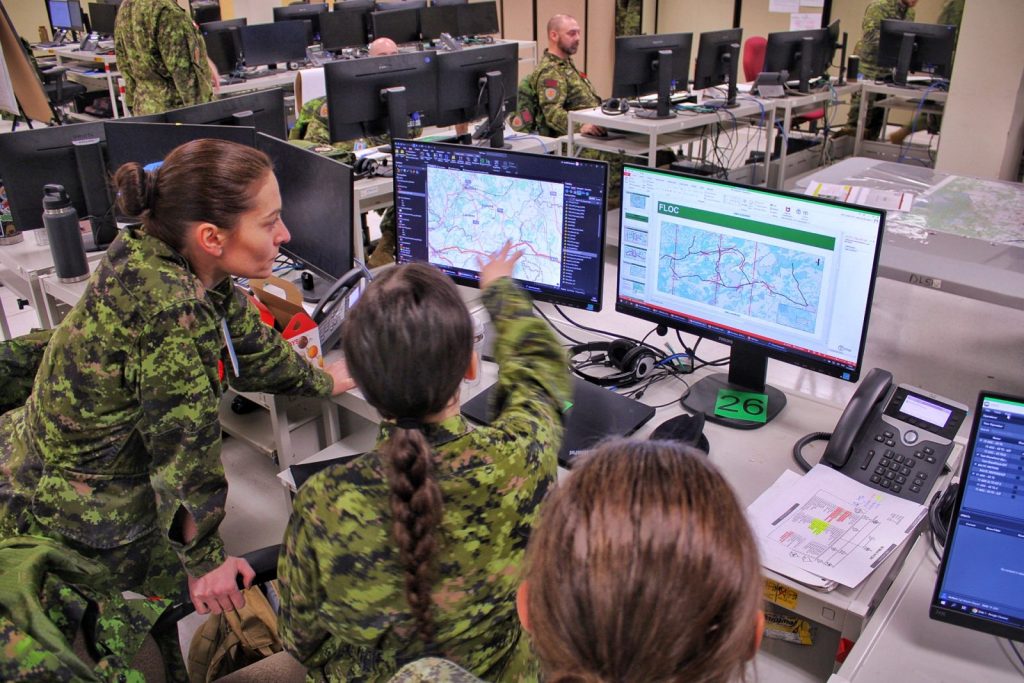by Chris Thatcher
The Army’s command-and-control (C2) footprint in Afghanistan was big and cumbersome, housed in large tents amid a sea of masts and emitting an electromagnetic signature for all to see. In a future conflict, it will need to be light and nimble, a multitude of mobile nodes easily reconfigurable to ensure the seamless flow of information.
The digital network being prepared for deployment in Latvia might not yet be all those things, but it will take the Army well down that path.
“We want to be less glowing and still achieve the same effect,” said Lieutenant-Colonel Ian MacLellan, who oversees a family of Land C4ISR projects within the Directorate of Land Requirements (DLR). “By dispersing throughout the battlespace, there will be reduced ability for the enemy to detect our command nodes.”
Upgrading some of the current systems and connectivity might be akin to switching 1990s era phones and DSL connections for 5G connectivity and speed, he joked, “but that is what we are trying to do, take that compute part of 20 years ago and reduce it to something that fits in a single, ruggedized case but still gives you the same services or more, in a smaller, mobile configuration.”
C4ISR, the catchall acronym for command, control, communications, computers, intelligence, surveillance, and reconnaissance, is a top priority for Army Commander Lieutenant-General Joe Paul. Three of the projects in the Army’s Land C4ISR modernization program will move into the definition phase of procurement later this year — the rest will follow over the following 18 months — but the projects are not expected to deliver capability until 2028 and beyond.
To ensure the brigade taking shape in Latvia has the necessary communications, sensors, and battle management system to enable the uninterrupted movement of data, the Army is rapidly acquiring and building the components for a digitally enabled network as one of several urgent operational requirements (UOR), although only scaled for Latvia; the wider Army will have to await the major projects delivering beyond 2028.
The C2 and information systems suite will include new battle management system software compatible with NATO partners in the brigade, radios, and crypto to securely enable the faster relay of information for C2 and digital fires.
“We want that proper situational awareness flowing across the battlespace,” said MacLellan, a Signals officer who previously worked on NATO interoperability with Canadian Joint Operations Command and on C4ISR sustainment as chief of staff for Director Land Command Systems Program Management.
Unlike some procurement projects that have slowed, so that staff at DLR and the Assistant Deputy Minister (Materiel) (ADM (Mat)) branch can focus on delivering an urgently required version to Latvia, the Land C4ISR program remains on track and moving in parallel with the brigade UOR. Though small, DLR and ADM (Mat) have created distinct teams to ensure both deliver on the current schedule.
LAND C4ISR
ISR Mod is expected to enter definition this spring and Tac Comm Mod and TacC2IS will follow, either by late 2024 or early in 2025. After incorporating feedback from a recent request for information (RFI), CFLEWM will follow in 2025, along with JDHQSRM and CJIM. All three will need to plug into the digital backbone and sensors delivered by the first three projects, so requests for proposals could be staggered accordingly.
“The Latvia mission creates challenges” because of the need to get modern capability into theatre quickly, MacLellan said. “[But] we have been very careful not to impact [Land C4ISR] while maintaining support to the field force.”

Briefing to BGen Stephane Masson, commander of 5th Canadian Division, by members of 37 Canadian Brigade Group during FallEx 23 in Gagetown. Photo: MCpl Stephanie Labossiere
Though the two streams are not explicitly structured to inform one another, Land C4ISR has adopted ADM (Mat)’s continuous capability sustainment model to ensure the technology across all six projects is refreshed in regular phases. That could mean Latvia plays a pivotal role shaping future evolutions of Land C4ISR.
“I don’t want to say we are leveraging one to inform the other, because they are going at the same time,” MacLellan noted. “The first phase for Latvia is expected to happen later this year, and if we get some lessons learned, those could inform the definition phase of SSE 42 as we transition from options analysis.
“If the operating model we use in Latvia becomes a model the Army wants to hold on to, it will influence the type of radios we buy, the type of software we buy, whether we have one battle management system or have a library of software we can customize for operations.”
The Land C4ISR program is drawing some inspiration from the Integrated Soldier System suite project, which recently changed tack from its first iteration of a military-specific tactical smartphone-like computer system to network platoon sized formations, and adopted commercial Samsung S-20 phones with Android Tactical Assault Kit (ATAK) software.
“I look at Latvia as an opportunity to show what we can do, given a challenge, to enable the Army to be better,” MacLellan said. “The equipment might not be what we buy with Tac Comm Mod or TacC2IS, but it will hopefully enable the operating concept to be better defined so we procure the right stuff.
“We can’t slow down, so the first capability might not be perfect. But we are going to use that continuous capability sustainment model to keep evolving — the technology evolves so quickly that we need to be more flexible and agile.”
Critically, procurement policy now supports such an approach and leadership in the Army and ADM(Mat) is committed to seeing it through. The Land C4ISR program, in particular, has been at the forefront of efforts to acquire technology in spirals to flatten the boom-and-bust waves that can occur when the Army only buys something every 10 or 15 years.
“If Latvia wasn’t [a prime mission], the leadership would not be looking at the problem the way they are,” he said. “It enables us to be more innovative in how we deliver SSE 42.”

Army Intelligence Regiment during Ex Tactical Star 23. Photo: MClp Conway Lalor
FAIL FAST OR SUCCEED FAST
In December 2023, the government announced the award of four Land C4ISR support contracts to General Dynamics Mission Systems-Canada (GDMS-C). It was the sort of yearend news release that often flies under the radar.
But for those developing C2 capability for Latvia and building the future network and suite of sensors, the separate long-term deals, valued at $1.68 billion over the first six years, were an important marker.
“That partnership is key to the future C4ISR capability,” said MacLellan, one of the architects of the contracts. “And there are pieces of those contracts that will ensure the success of Latvia.”
The four contracts provide sustainment services for system of systems engineering and integration; the core network; intelligence, surveillance, target acquisition and reconnaissance (ISTAR); and various applications — all crucial to the Army’s ability to achieve situational awareness, manage and exchange information, and plan and direct operations.
Through the engineering and integration contract, the Army has access to a digital sandbox — what GDMS-C calls Battle Lab — for its engineers and industry partners to experiment and innovate as they “look at options for the future,” he said.
In line with LGen Paul’s goal of fast-tracking successful experiments from domestic exercises into theatre, the Battle Lab will allow “eco-systems to ‘fail fast’, or ‘succeed fast’, and determine if a particular capability needs more funding, additional user feedback, or if a new solution should be sought for a particular use case,” explained Andrew Shepherd, vice president of Land and Joint Solutions.
GDMS-C is responsible for sustaining the baseline C4ISR systems in service, while simultaneously working on the next release and the architecture to integrate future capabilities. If previously those were managed as separate streams, that Battle Lab structure allows all three to be trialed and evaluated in a concurrent manner.
“If there is a deployed solution or use case in the field that is not working for the user, that requirement can quickly be brought to the Battle Lab where it can work alongside different applications, systems or platforms, in order to get something that meets the user’s requirements,” said Shepherd. “With the changing pace of today’s technology, this collaborative environment aids in urgent rapid delivery to the user, as well as propelling forward looking solutions that will give the CAF a competitive advantage.”
Whether its GDMS-C’s proprietary systems, other vendors’ radios, sensors, electronic warfare systems, new software, cloud capability, or Army problems with the digital spine of its network, proof of concepts can be designed and assessed in the sandbox. Vital for the Army, that level of testbed activity can ensure all the interdependencies and downstream effects of adding new capabilities are understood before anything is deployed, said MacLellan.
Many of the projects in the Land C4ISR portfolio were conceived in 2009 and the landscape and how capabilities are delivered has changed radically, he noted. “That is the big thing we have learned from industry engagement and the RFIs — we have missed some things because they are leaps and bounds ahead in some of these spaces.”
“When dealing with the world of C4ISR, it’s really a try before you buy experience,” said Shepherd. “And even in the try-and-buy phase, you do not have to be stuck with a particular capability for a decade, or even years. The ability to quickly onboard and off-board software, is a new dimension that Canada is quickly starting to understand better.”

